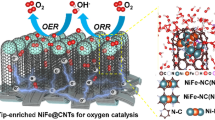Abstract
Urchin-like Sn–ZnO–C composite have been successfully prepared by thermal annealing of ZnSn(OH)6 precursor in acetylene/argon gas (1/9; v/v). The phase of the urchin-like Sn–ZnO–C has been characterized by X-ray diffraction (XRD) and Raman spectrum. The images of scanning electron microscopy (SEM) and transmission electron microscope (TEM) demonstrate that the Sn–ZnO–C composite with an average of 3 μm in diameter is composed of many core–shell nanowires and carbon nanotubes emanated from the center. The thermal annealing temperature and time have crucial effects on the formation of urchin-like structure and carbon content of the Sn–ZnO–C composites. As an anode for lithium-ion batteries, the urchin-like Sn–ZnO–C composite delivers a discharge capacity of 1,034.5 mAh/g in initial cycle and 571.9 mAh/g reversible discharge capacity after 25 cycles at a current density of 50 mA/g. The superior energy storage properties highlight the urchin-like Sn–ZnO–C composite as a potential alternative anode material in lithium-ion batteries.




Similar content being viewed by others
References
Reddy MV, Subba Rao GV, Chowdari BVR (2013) Metal oxides and oxysalts as anode materials for Li ion batteries. Chem Rev 113:5364–5457
Park CM, Kim JH, Kimc H et al (2010) Li-alloy based anode materials for Li secondary batteries. Chem Soc Rev 39:3115–3141
Winter M, Besenhard JO, Spahr ME et al (1998) Insertion electrode materials for rechargeable lithium batteries. Adv Mater 10:725–763
Winter M, Besenhard JO (1999) Electrochemical lithiation of tin and tin-based intermetallics and composites. Electrochim Acta 45:31–50
Deng D, Kim MG, Lee JY et al (2009) Green energy storage materials: nanostructured TiO2 and Sn-based anodes for lithium-ion batteries. Energy Environ Sci 2:818–837
Fu ZW, Huang F, Zhang Y et al (2003) The electrochemical reaction of zinc oxide thin films with lithium. J Electrochem Soc 150:A714–A720
Chae OB, Park S, Ryu JH et al (2013) Batteries electrode by embedding in carbon matrix for lithium-ion performance improvement of nano-sized zinc oxide. J Electrochem Soc 160:A11–A14
Huang JY, Zhong L, Wang CM et al (2010) In situ observation of the electrochemical lithiation of a single SnO2 nanowire electrode. Science 330:1515–1520
Xu LP, Kim C, Shukla AK et al (2013) Monodisperse Sn nanocrystals as a platform for the study of mechanical damage during electrochemical reactions with Li. Nano Lett 13:1800–1805
Shen XY, Mu DB, Chen S et al (2013) Enhanced electrochemical performance of ZnO-loaded/porous carbon composite as anode materials for lithium ion batteries. ACS Appl Mater Interf 5:3118–3125
Zhang HL, Zhang Y, Zhang XG et al (2006) Urchin-like nano/micro hybrid anode materials for lithium ion battery. Carbon 44:2778–2784
Yang SJ, Nam S, Kim T et al (2013) Preparation and exceptional lithium anodic performance of porous carbon-coated ZnO quantum dots derived from a metal-organic framework. J Am Chem Soc 135:7394–7397
Liu JP, Li YY, Ding RM et al (2009) Carbon/ZnO nanorod array electrode with significantly improved lithium storage capability. J Phys Chem C 113:5336–5339
Kramer JW, Kelly B, Manivannan V (2010) Synthesis of MSn(OH)6 (where M = Mg, Ca, Zn, Mn, or Cu) materials at room temperature. Cent Eur J Chem 8:65–69
Zhang X, Xing Z, Wang LL et al (2012) Synthesis of MnO@C core-shell nanoplates with controllable shell thickness and their electrochemical performance for lithium-ion batteries. J Mater Chem 22:17864–17869
Zhang WM, Hu JS, Guo YG et al (2008) Tin-nanoparticles encapsulated in elastic hollow carbon spheres for high-performance anode material in lithium-ion batteries. Adv Mater 20:1160–1165
Zhu XJ, Geng LM, Zhang FQ et al (2009) Synthesis and performance of Zn2SnO4 as anode materials for lithium ion batteries by hydrothermal method. J Power Sources 189:828–831
Acknowledgments
This work was supported by the National Natural Science Foundation of China (91022033 and 21201158), the National Basic Research Program of China (2011CB935901), Anhui Provincial Natural Science Foundation (1208085QE101), and the Fundamental Research Funds for the Central Universities (WK 2340000027).
Author information
Authors and Affiliations
Corresponding author
About this article
Cite this article
Fan, L., Zhang, J., Zhu, Y. et al. Synthesis of urchin-like Sn–ZnO–C composite and its enhanced electrochemical performance for lithium-ion batteries. Chin. Sci. Bull. 59, 2006–2011 (2014). https://doi.org/10.1007/s11434-014-0278-6
Received:
Accepted:
Published:
Issue Date:
DOI: https://doi.org/10.1007/s11434-014-0278-6




